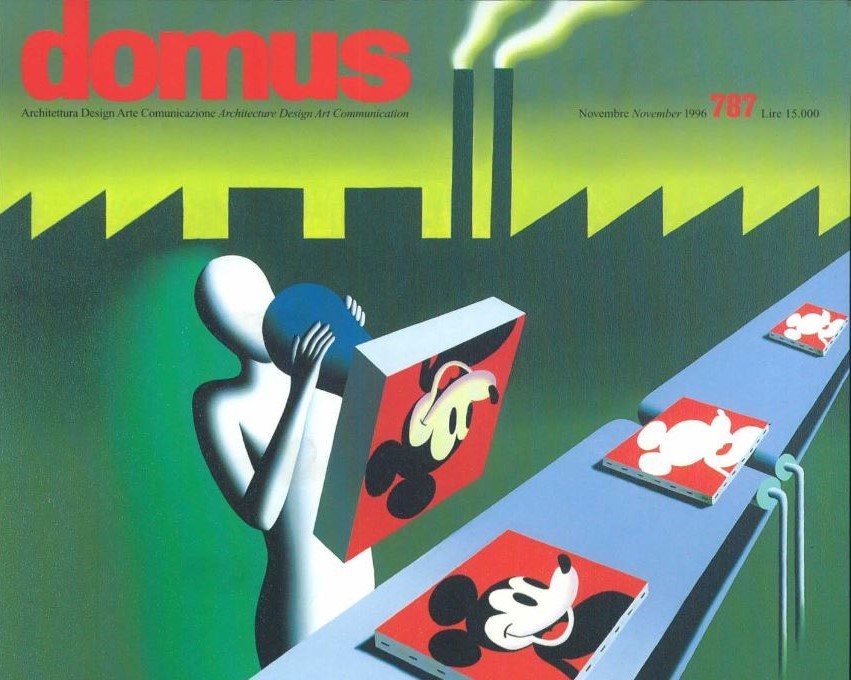On October 16, 1923, one of the most powerful entities by far in shaping collective culture was founded. We are talking about the Walt Disney Company, which from Burbank, California, from Mickey Mouse onward created imagery as beloved as it was criticized as an instrument of a political pervasiveness little lower than that of official diplomacies.
It started with comic books, with cartoons, but soon landed in the physical world with merchandising, and especially with architecture and urban planning: the legendary theme parks, starting with opening of the first Disneyland in Anaheim, Los Angeles in 1955, but it also expanded in a wide display of corporate architecture, that in the second half of the century brought to the Disney world famous names such as Isozaki, Gehry, Venturi, and Graves.
In November 1996, Domus had devoted an issue, 787, to what it called “the Disney syndrome,” to “prepare ourselves for the Disney onslaught and its attendant, simultaneously naive and enthralling world, where business interests are out to conquer the leisure society,” as François Burkhardt wrote.
Recent corporate projects and theme parks spread around the world were presented, and questions were asked about what episodes and thoughts of nineteenth- and twentieth-century architecture lay in their background, as happens in this test by Stanislaus Von Moos that we repropose, as an introduction to an entire volume.
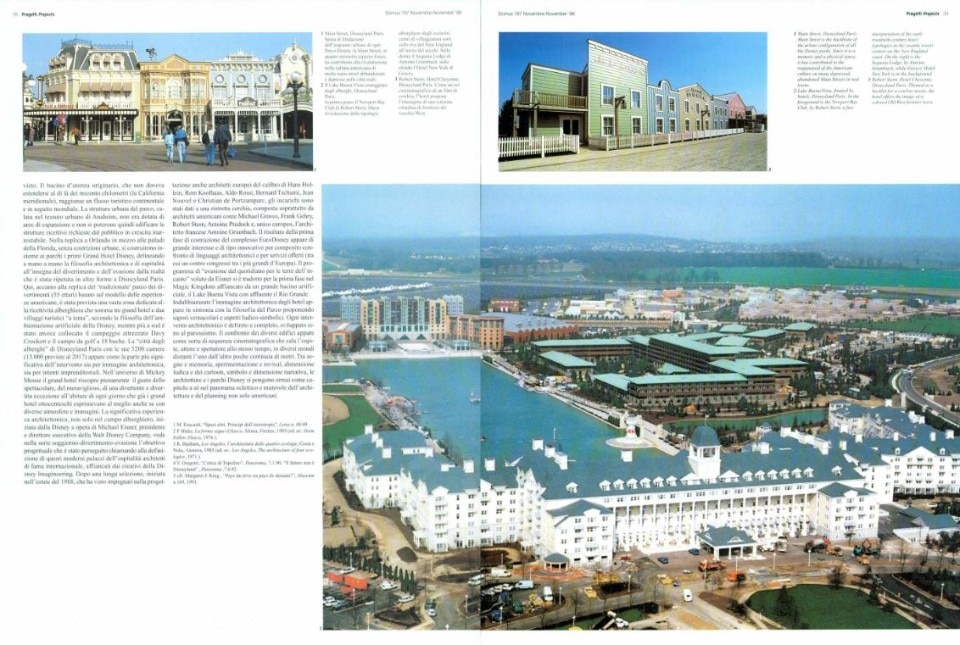
The “Disney Sindrome”
1. ‘Serious’ architectural history has ignored Disneyland. A moralising historiography that has sworn allegiance to the Utopian ideals and morals of Modernism is incapable of even noticing the phenomenon; first and foremost because the Utopian content - the analogy between the centralised layout with its radial network of paths and Ebenezer Howard s schematic design for the Garden Cities of Tomorrow (1903) speaks to a certain degree for itself- has been distorted beyond recognition by the commercial context. And yet, on the other hand, it is precisely the fictional aspect of this lebensraum which is infact not a Lebensraum (since no-one actually lives in Disneyland) that enables it to draw together a number of the ideas and topics of reformistic thinking in urban design to form a ready-made teaching aid. Thus, it was with good reason that Charles Moore could write about Disneyland in 1965 in a legendary issue of the magazine Perspecta as if he was writing about a piece of re-discovered small town identity in the midst of Californian suburbia.

Moore went so far as to declare Disneyland to be the “most important coherent piece of architecture of recent decades in the American West.” That was, as I said, 1965, and one only has to bring to mind the ingenious transport system in order to understand why at the time an architect of Moore’s generation would have been so enthusiastic about Disneyland. In this Utopia, public transport and its user - the pedestrian - are trumps, while the car just about survives as a toy on the little freeway ramps where the visitors can experience en miniature the inferno they have just fled from on the overcrowded freeway outside. As I said, in Disneyland the pedestrian is king. And naturally along Main Street throbs the commercial pulse of the whole operation. Main Street: its function relentlessly commercial, its character nostalgic, its scale reduced and its style programmatically pluralistic and eclectic. Basically, it is a piece of urban reconstruction: no more and no less, at least so people say, than an exact copy of the main street of Marcelin, Missouri - the birth place of Walt Disney. Here there are hoards of souvenir shops, snack bars, cafes and cinemas.
What is more, they are allpacked in buildings which, right down to their bricks and rooftiles, are reduced to five-eighths of their normal size, something which the visitor does not immediately notice yet which in retrospect makes the impression all the more lasting. Of course, we all know that miniaturisation, in the sense of forced perspective, is one of the classic tricks of the cinema and is also, not just since Palladio and Scamozzi, one of the basic tools of stage design. And, of course, miniaturisation is the universal characteristic of toys - which brings us backfull circle. The visitor, separated from his car as soon as he enters the park and thus deprived of his civil rights, becomes a child again. The buildings on Main Street draw him into a game. He feels like he is in a fairy story.
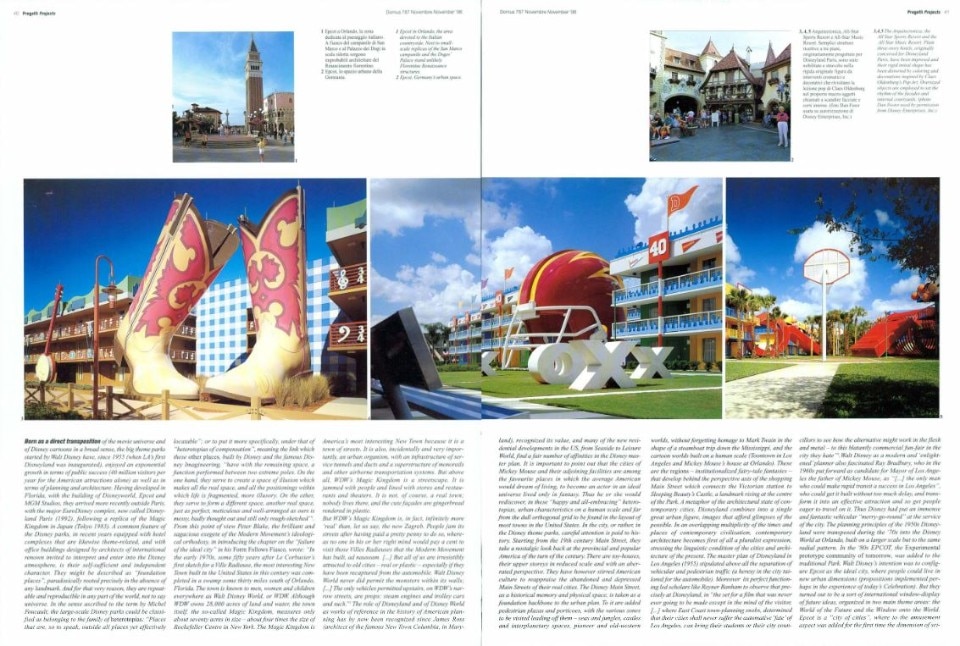
2. One can probably get closest to the whole idea if one interprets Disneyland as a reconstructed and mummified conglomerate of the obsessions and repression myths of the 19th century in built form. Virtually everything that is typical for Disneyland (and all the more so for Disney World, the second Disney Leisure Park, built in Florida in the seventies) was originally one of the elements that at, the latest by 1867, constituted the World Fairs. First of all, in purely spatial terms, the idea of removing the exhibition grounds from their urban context, the elimination of private motor traffic and the organisation of an efficient system of omnibuses, horse-drawn trams and metro systems to take visitors to the exhibition grounds and ensure their mobility within it (something which, for example, could be copied with ease from the Paris World Fair of 1867).
Then in terms of content: the dramatisation of advanced technology (as in the Galerie des Machines) in connection with the depiction of cultures that were remote both in terms of time and space, for instance, in the form of eclectic national pavilions scattered around and in the form of the built history of housing of all nations which was realised in 1889 at the foot of the Eiffel Tower (incidentally, to plans by Charles Garnier). Compared with all that - and the teaching and pleasure gardens of the 18th century have not even been mentioned, nor have the pilgrimage places and Sacri Monti of the Counter Reformation with their replicas of important places from the history of Christianity grouped in Baroque ghost towns, inside which episodes from the Bible are reproduced as tableaux, often life-size, and can be looked at through windows - compared to all that Disneyland is a commercial rear-guard action by the world of yester year. Here America is reproducing some of the atavistic rituals of the old world, respectably deprived of their magic, as fun without mysticism. The only mystique that remains is that which in a rather transparent way surrounds the dream of the hegemony of Euro-american culture and the priority of the whites over all other races of the earth.
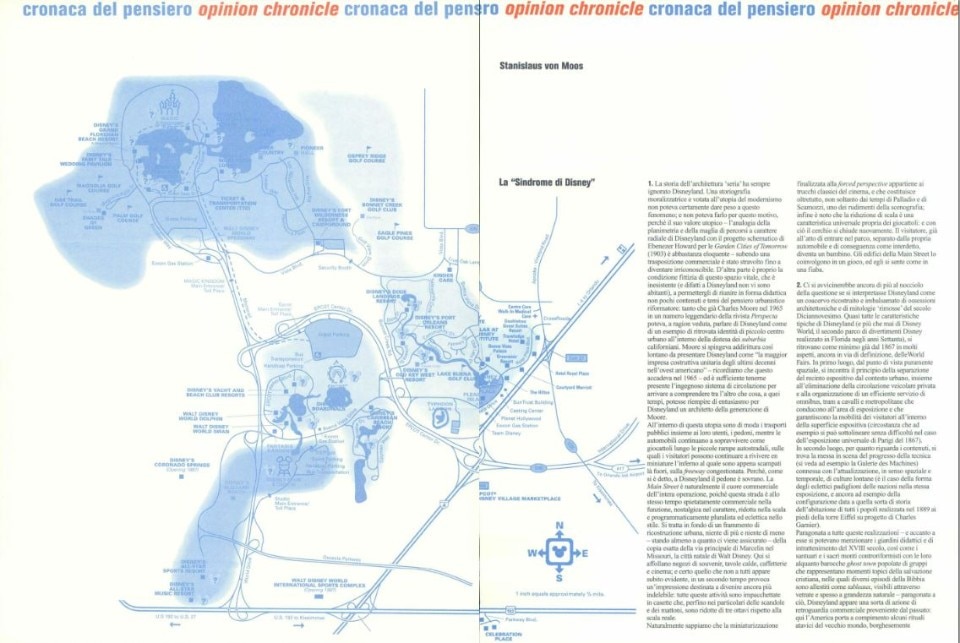
3. And yet it is perfectly possible that the whole thing seen in a sober light could be understood in a far simpler way: as a variation on a problem that was also central to the discussion about ‘serious’ architecture in the fifties. This was a time when a considerable number of European cities were confronted with the task of repairing city centres that had been destroyed in the war or even, in places such as Warsaw, Freudenstadt or Münster/Westphalia, completely re-building them from scratch. In comparison to the work there, Main Street is the American version of a building project which “was in the air” in Europe at the time. The topic was incidentally not just the hobbyhorse of traditionalist reconstruction fanatics. The cult of the pedestrian and the ruthless elimination of the automobile have made Disneyland into a kind of stowaway with the Ciam avant-garde and thus a silent companion of the kind of urban reform that Victor Gruen, for example, was developing projects for, some of which were also built.
Even Le Corbusier himself anticipated Disneyland (and incidentally also Warsaw) in 1934 when he called upon the transport system in Venice to ‘testify’ in the context of a project for Antwerp (La ville radieuse) and in doing so reduced the problem of Venice to the terms autosilo, vaporetto and San Marco. For Ciam (Congres Internationaux d Architecture Moderne), 1951 was the all important year: it was then, during their 8th meeting in Hoddesdon, that they began to debate seriously the problem of redeveloping historical city centres, speaking of the “heart of the city”, the ‘core’ and adopting the slogan “humanisation of the city” as their idea for a solution. The pictures of Saint Mark’s Square and Piazzetta were brought out again as if there was a need to re-establish the continuity with the traditionalist pictorial language of the world fairs (and at the same time anticipate the miniature replica of the Piazza San Marco in the Epcot Center at Disneyworld in Orlando, Florida).
And Giedion, the secretary general of Ciam, enthused about Züriäscht (1951): “The man on the street [...] no doubt has to get away from the one at a football match. It requires of him - unlike the man of the 19th century — that he takes part in the life of the city and plays the role allocated to him”. An “excellent example of the unconscious urge,” he said, was the festival that the city of Zurich celebrated in June 1951 to mark the 600th anniversary of its joining the confederation.
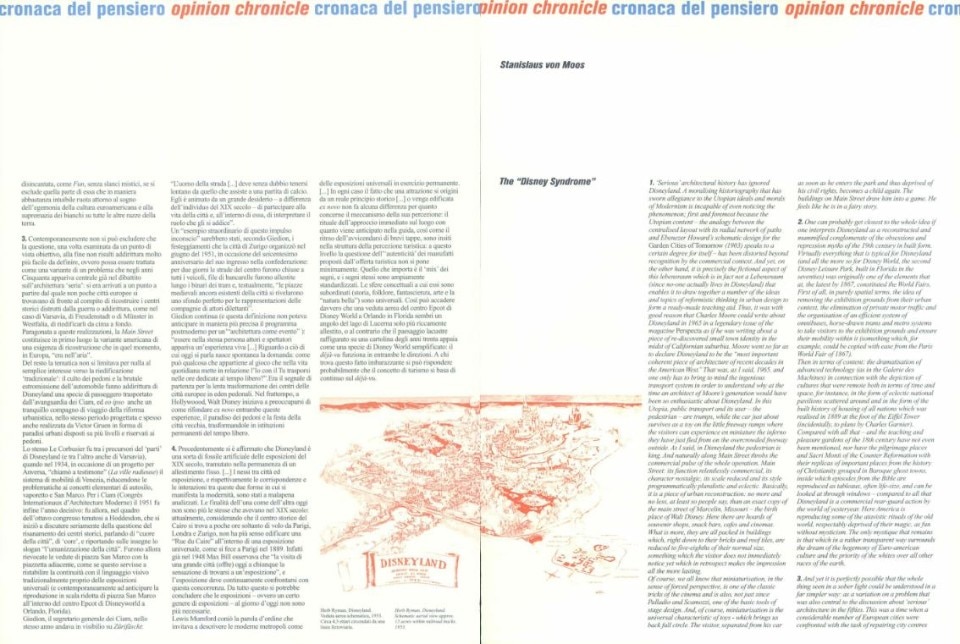
For two days the streets in the city centre were closed to traffic, rows of benches were set up across the tram lines and, in the words of Giedion: the medieval squares of the city that still exist turned out to be a superb background for the performances of the amateur dramatic groups And he continued (the wording could not have anticipated more precisely the programme of post Modernist “adventure playground architecture”): “To be one of the actors and one of the audience in one person seemed to be afervent desire. [...] The burning question today is: how can something of the interplay between ‘I’ and you’in daily life low into the leisure hours?” It was the starting signal for the gradual conversion of the European city centres into pedestrian paradises. At the same time in Hollywood Walt Disney was beginning to think about how he could combine the pedestrian paradise and the historical city festival and create a permanent leisure institution.

4. Disneyland, as it was argued above, is a kind of fictitious fossil of the 19th century world fairs that has been made into a permanent institution. [...] The relationship between city and fair, or rather the connections and interaction between these two manifestations of modernity have hardly been investigated. The tasks of both are no longer those of the 19th century. At a time when the city centre of Cairo is only a few hours by plane from Paris, London and Zurich, there is no longer any need to build a replica of the “Rue du Caire” at a world fair, as was the case in Paris in 1889. As early as 1948, Max Bill said, “the visit to a larger city today (offers) everyone the sensation of being at an exhibition.” From then on, he said, exhibitions would have to take this competition into account. One could conclude from that that exhibitions - or at least certain kinds of exhibition - are barely necessary today.
It was Lewis Mumford who said that modern metropolises could be described as permanent world fairs. [...] Be that as it may: whether one of the sights of a city comes from the genuine storehouse of history [...] or whether it has been fabricated ex novo, like in Disneyland does not change the mechanism with which it is perceived: the rite of the direct encounter with the object that has been promised in the guidebook or the rhythm of a rapid succession of changes within a short time are both predetermined by the tourist’s way of perceiving things. Whether the artifacts on offer are authentic is not even questioned on this level. What is most important is the mix of symbols and the symbols themselves are to a large degree standardised. The areas they are allocated to (history, folklore, technological fantasies, art or beautiful countryside) are universally present in the human imagination. Thus it can happen that an aerial photograph of the Epcot Center of Disney World in Orlando, Florida, looks like a richly decorated bay on the Lake of Lucerne or, vice versa, the bay on Lake Lucerne on a postcard from the thirties looks like a rather paltry version Disney World: the feeling of déjà-vu works both ways. To anyone who finds that fatal you would probably have to say that this feeling of déjà-vu is the most important thing in tourism.


